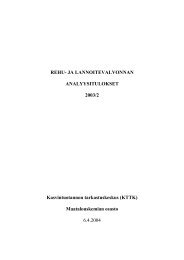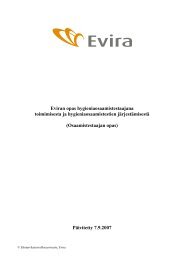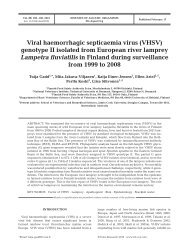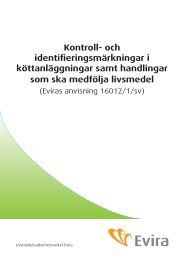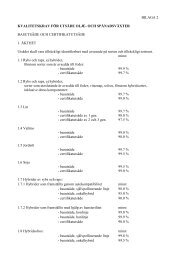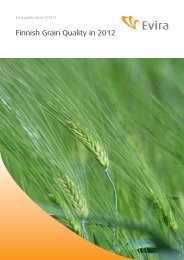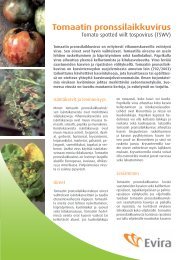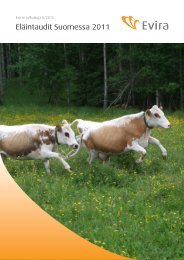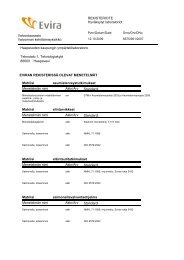Genetic characteristics of field and attenuated rabies viruses ... - Evira
Genetic characteristics of field and attenuated rabies viruses ... - Evira
Genetic characteristics of field and attenuated rabies viruses ... - Evira
You also want an ePaper? Increase the reach of your titles
YUMPU automatically turns print PDFs into web optimized ePapers that Google loves.
dynamics <strong>of</strong> a potential <strong>rabies</strong> outbreak in an immunized fox population after the<br />
termination <strong>of</strong> a long-term, large-scale vaccination programme with two campaigns per<br />
year: one in spring <strong>and</strong> the other in autumn. The use <strong>of</strong> integrated approaches, such as<br />
the geographical analysis <strong>of</strong> sequence variants, coupled with information on spatial<br />
dynamics is an indispensable aid to underst<strong>and</strong> the patterns <strong>of</strong> disease emergence (Real<br />
et al., 2005).<br />
1.6. Fixed strains <strong>of</strong> <strong>rabies</strong> virus<br />
1.6.1. Laboratory strains<br />
Two laboratory strains, the CVS (Challenge/Control Virus Strain) <strong>and</strong> PMPV<br />
(Pitman-Moore Pasteur Virus), are widely used. Both strains are considered to be<br />
derivates <strong>of</strong> the original Pasteur virus strain (Smith et al., 1993). The CVS strain has two<br />
stable variants: CVS-B2c <strong>and</strong> CVS-N2c, these differ in pathogenicity for healthy mice <strong>and</strong><br />
in the capacity to affect neurons (Morimoto et al., 1999). These laboratory strains are<br />
used in different diagnostic tests such as the virus neutralization <strong>and</strong> focus inhibition<br />
tests, as well as for the potency testing <strong>of</strong> anti-<strong>rabies</strong> vaccines in laboratory animals.<br />
1.6.2. Vaccine strains <strong>and</strong> anti-<strong>rabies</strong> vaccines<br />
Since the first <strong>rabies</strong> vaccination in 1885 by Louis Pasteur (Pasteur, 1885),<br />
significant progress has been made in improving the pre- <strong>and</strong> post-exposure treatment <strong>of</strong><br />
human <strong>rabies</strong> (Dietzschold et al., 2003). There are several types <strong>of</strong> vaccines: live<br />
<strong>attenuated</strong>, inactivated (killed), DNA-based, <strong>and</strong> vector vaccines. For the production <strong>of</strong><br />
anti-<strong>rabies</strong> vaccines, a number <strong>of</strong> <strong>attenuated</strong> vaccine strains are employed: the Pasteur<br />
Virus (PV), Evelyn Rokitniki Abelseth (ERA), Street-Alabama-Dufferin (SAD), 3aG,<br />
Fuenzalida S-51 <strong>and</strong> S-91, Ni-Ce, SRV9, PM, Nishigahara, RC-HL, Kelev, Flury,<br />
“Shelkovo-51”, “O-73 Uz-VGNKI”, “RV-71”, “Krasnopresnenskii-85”, <strong>and</strong> the RV-97 strain<br />
(Steck et al., 1982; Fodor et al., 1994; Gruzdev <strong>and</strong> Nedosekov, 2001; Ito et al., 2001b;<br />
Borisov et al., 2002). The PV is one <strong>of</strong> the first vaccine strains; it was isolated from a<br />
rabid cow in 1882 <strong>and</strong> <strong>attenuated</strong> by multiple passages in rabbits. The SAD strain was<br />
isolated from a rabid dog in Alabama (USA) in 1935 <strong>and</strong> adapted for cultivation in the<br />
mouse brain <strong>and</strong> in the baby hamster kidney cell culture. It has two main derivates: ERA<br />
<strong>and</strong> Vnukovo-32. Several variants <strong>of</strong> the SAD strain exist: SAD-Berne, SAD B19, SAD-<br />
P5/88 etc., <strong>and</strong> also non-virulent mutants SAG-1 <strong>and</strong> SAG-2. The vaccine strains<br />
belonging to the SAD group are widely used throughout the world. One <strong>of</strong> the most<br />
25



